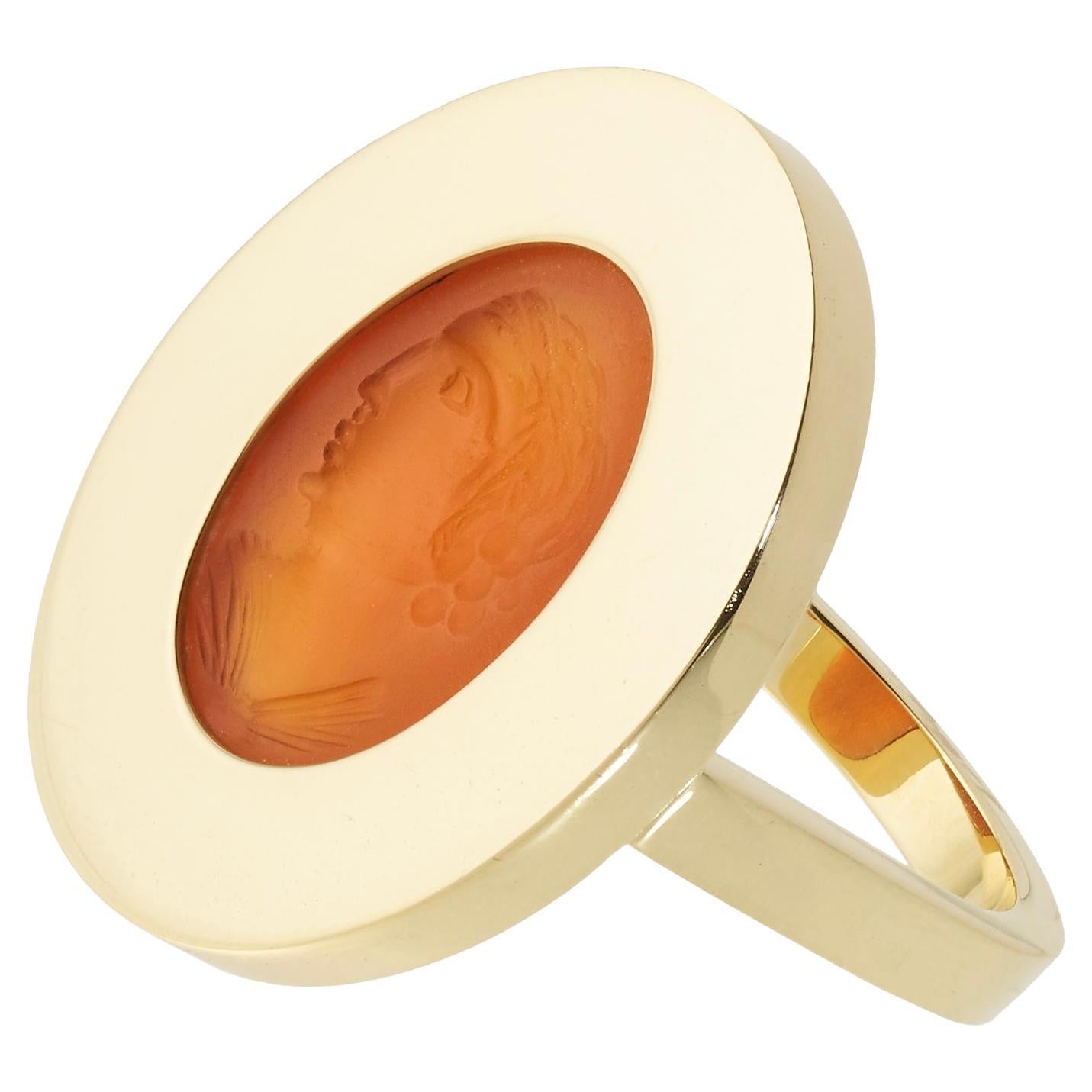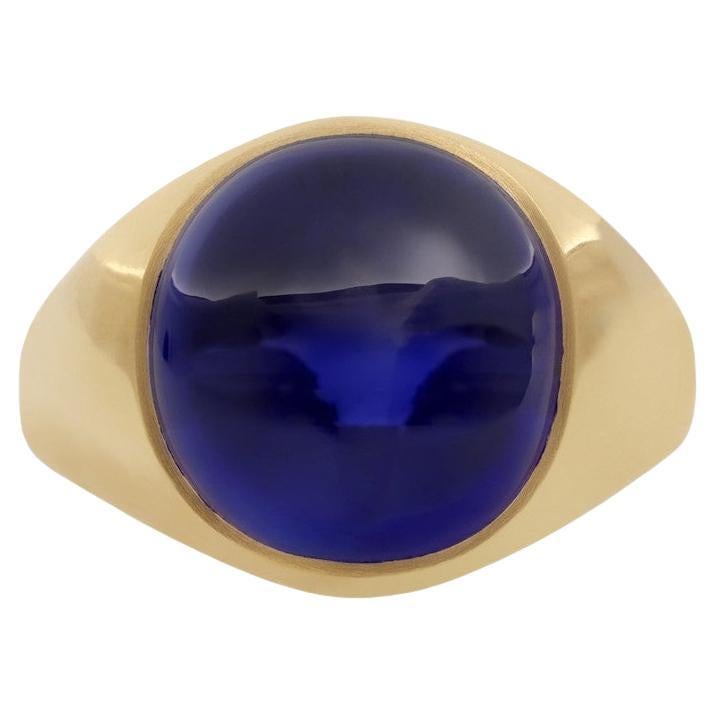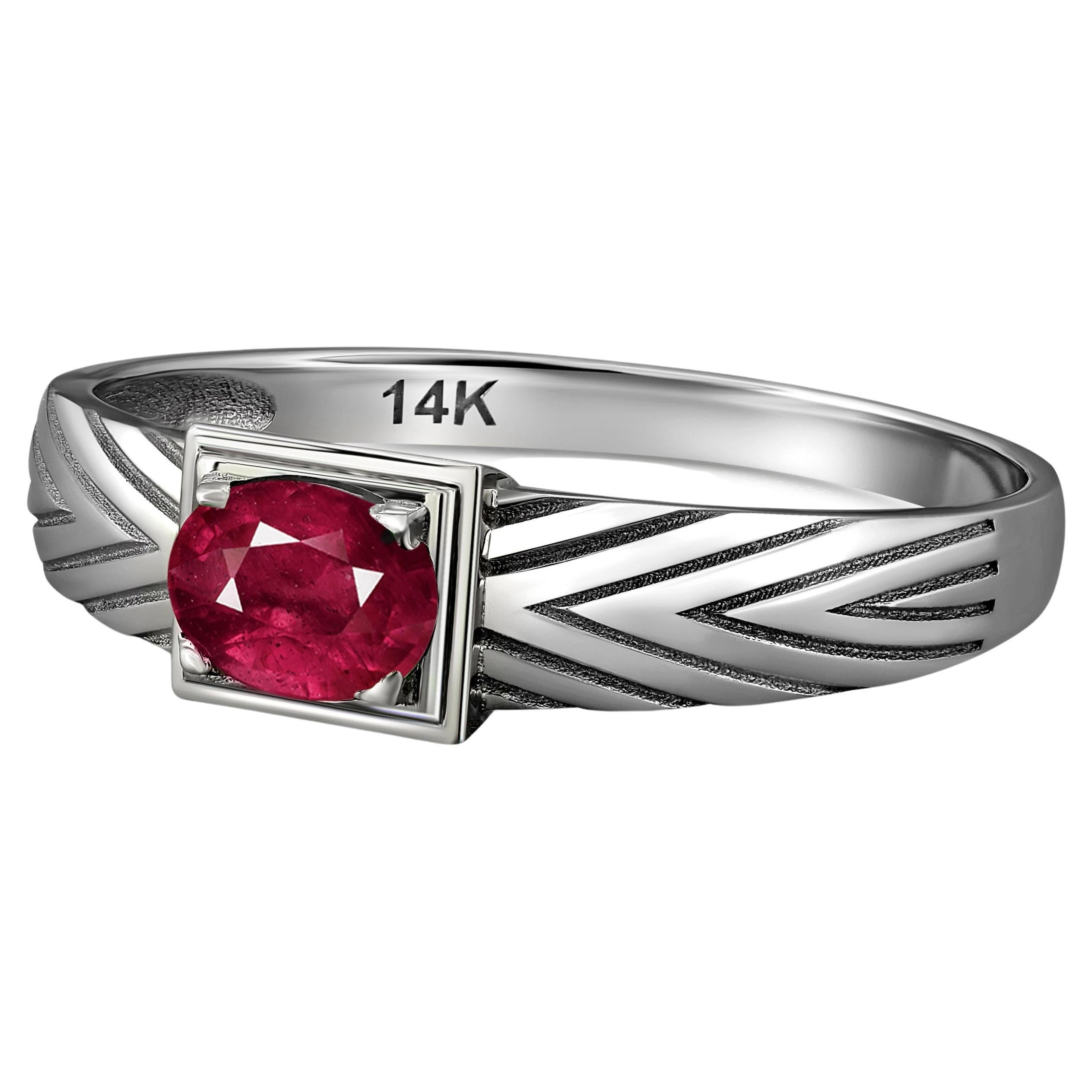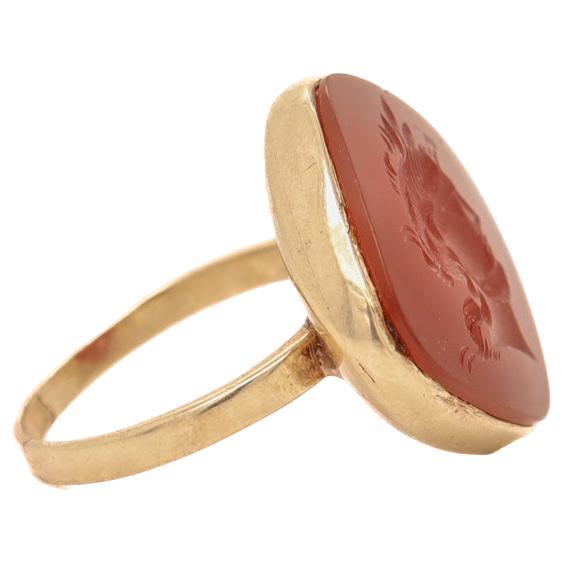Items Similar to Ancient Javanese Gold Ring with Ruby Cabochon Java Indonesian Antique Solitaire
Want more images or videos?
Request additional images or videos from the seller
1 of 20
Ancient Javanese Gold Ring with Ruby Cabochon Java Indonesian Antique Solitaire
About the Item
A scarce early Javanese gold and ruby ring dating from the 7th-15th century Indonesian Classical period.
As expected with Javanese gem-set gold rings made in this period, the present ring is crafted high-karat gold and set with a polished cabochon. The ring has a circular bezel, holding a ruby of approximately 0.7cts. The ruby is of a pinkish red colour and features natural inclusions throughout. The protuberant, stirrup-shaped shoulders of the ring are designed to mimic the shape of water buffalo horns, a typical characteristic of Javanese rings.
One of the largest and most important islands in the Indonesian archipelago, Java has long been a great centre of art and civilisation. Gold finger rings are the most common form of jewellery found on ancient Java. Inventories of gold artefacts found in archaeological excavations reinforce the notion that rings were ubiquitous during this period. Not only was gold jewellery a significant symbol of wealth, status and power - but it was also used a currency in itself and functioned as standardised payment for numerous goods and services like salaries, fines and wedding banquets. In ancient Java, rings were also believed to have magical properties; predominantly the ability to bring good fortune and protection to the wearer. In fact, the literal meaning of the word ‘ring’ in Old Javanese translates to ‘guardian against enemy’.
Although corundum (sapphires and rubies) is not local to Java, they are often found on ancient Javanese rings and would have originally come from Sri Lanka, Myanmar or Central Asia. The stones on ancient gem-encrusted Javanese rings were not only chosen for their beauty and value, but also for their supposed astrological, magical and medicinal powers.
UK ring size J, US size 4.75
7.13g of high karat gold (19K/20K gold)
Despite its impressive age, the ring is in wearable condition. The stone is securely set; however under loupe magnification there is a small chip to one of the corners of the ruby.
Stone measures 7mm x 6mm. Band measures 2mm across at the back, and about 10mm at the front. Stone tested as corundum (ruby).
- Ring Size:4.75 US, Resizable
- Metal:
- Stone:
- Stone Cut:
- Weight:7.13 g
- Place of Origin:Java
- Period:
- Date of Manufacture:1100
- Condition:Wear consistent with age and use.
- Seller Location:London, GB
- Reference Number:1stDibs: LU2845222127542
Resizing is available.
About the Seller
5.0
Vetted Seller
These experienced sellers undergo a comprehensive evaluation by our team of in-house experts.
Established in 2019
1stDibs seller since 2022
32 sales on 1stDibs
Typical response time: 11 hours
- ShippingRetrieving quote...Ships From: London, United Kingdom
- Return PolicyA return for this item may be initiated within 14 days of delivery.
More From This SellerView All
- Small Ancient Indus Valley Bead Ring Etched Carnelian Cone Antique Gold RingLocated in London, GBA superb and rare ancient Indus Valley etched carnelian bead ring. The conical shaped carnelian gemstone in the centre dates from the middle of the third millennium BC. Deep orange in colour with white patterned etchings, these beads originate from the Indus Valley civilisation (parts of modern day Pakistan and India). These carnelian beads were alkaline-bleached to develop the geometric white patterns visible on the exterior. The technique was first developed by the Harappans of the Indus Valley civilisation, and vast quantities have been found in archaeological sites all across the Indus Valley. The conical stone has been set in a later high-karat gold ring mount, the hoop is hollow and of circular cross section which widens towards the bezel. This design and shape is typical of ancient gold rings...Category
Antique 18th Century Indian Signet Rings
MaterialsCarnelian, Gold
- Small Ancient Roman Period Gold Garnet Cabochon Ring AntiqueLocated in London, GBSmall Ancient Roman Period Gold Garnet Cabochon Ring A beautiful example of a Roman garnet cabochon-set gold ring! It displays a Type 2b Rom...Category
Antique 15th Century and Earlier Italian Classical Roman Solitaire Rings
MaterialsGarnet, Gold
- Ancient Roman Carved Red Jasper Gryllus Signet Ring Antique GeorgianLocated in London, GBAn ancient Romano-British carved jasper intaglio dating from the 2nd to 3rd century AD, set in a later gold mount dating from the late 18th century. The intaglio is intricately carve...Category
Antique 15th Century and Earlier Italian Georgian Signet Rings
MaterialsJasper
- Georgian 18th Century Signet Ring with Ancient Roman Nicolo Intaglio of HerculesLocated in London, GBA superb ancient Roman nicolo intaglio set in a late 18th century gold signet ring. Nicolo intaglios are a particular type of intaglio ma...Category
Antique Late 18th Century English Georgian Signet Rings
- Ancient Roman Green Chalcedony Plasma Intaglio Ring of Goddess Victoria NikeLocated in London, GBA scarce ancient Roman intaglio dating from the 1st to 2nd century AD, depicting Victoria, the Roman Goddess of Victory (also known as Nike in Greek mythology). The cabochon gemstone is a chromium chalcedony, mottled green in colour. It was known in the ancient world as a ‘plasma’ stone and was widely used in jewellery and seals throughout the Roman Empire. However the mineral disappeared from use in the ancient world towards the end of the 2nd century AD when the known deposits were mined out. The intricate ancient engraving depicts a winged Victoria, draped and facing left, holding a palm branch in her right hand and a laurel leaf in her left. The green gem is translucent and contains small dotted black natural inclusions. The gemstone’s viridian green tones were linked to nature, growth, and prosperity, reflecting the Romans' appreciation for abundance and fertility. Victoria played a major part of Roman society, with many temples erected in her honour including one on the Palatine Hill which would house the spoils of war from Roman victories. She was, to the Romans, a symbol of victory over death, ultimately determining who would be successful during war. The high number of artistic and architectural dedications to her bear witness to the popularity of the goddess’ cult: Victoria widely appears on Roman coins...Category
Antique 15th Century and Earlier Italian Classical Roman Signet Rings
MaterialsChalcedony, 22k Gold
- Rare Ancient Egyptian Carved Carnelian Frog Amulet Swivel Ring 18th DynastyLocated in London, GBThis rare Egyptian carved carnelian frog amulet dates to the Eighteenth Dynasty of the New Kingdom, circa 1300 BC. Frog amulets, depicting the goddess Heket, were commonly worn by both the living as a fertility charm and the dead to provide rejuvenation and a long afterlife. The ancient amulet is pierced horizontally and set into a later gold swivel mount, probably dating from the late 19th century. The design of the gold mount inspired by rings worn by the ancient Egyptians and Etruscans with its swivel bezel and coiled wire on the shoulders. The immense number of offspring made the frog an important symbol of fertility in ancient Egypt, and carved frog amulets were worn by women hoping for an easy delivery. This is exemplified with the goddess and protector of birth, Keket, who was depicted as a frog. After death, frog amulets would be placed within the wrappings of mummies, both men and women, in hope of a successful rebirth in the afterlife. The association between this amphibian and rebirth may have been induced by the fact that every year, millions of frogs spontaneously appeared out of the river mud and filled the fields after the annual inundation of the Nile. This caused the Egyptians to believe that they spontaneously generated themselves out of the river mud. The influence of frogs in Ancient Egypt can be seen in the language, the hieroglyphic sign for "one hundred thousand" was a tadpole, and one of the Egyptian terms denoting "frogs" is whm-anx, meaning literally "they who repeat life." Similar examples of ancient Egyptian carved...Category
Antique 15th Century and Earlier Signet Rings
MaterialsCarnelian, 22k Gold
You May Also Like
- Ancient 9th or 10th Century 22K Yellow Gold Javanese Sri RingLocated in Staines-Upon-Thames, GBAn ancient gold ring, with Sri inscription, in 22 karat yellow gold. This unique, unusual ring is steeped in history. Hailing from the 9th or 10th Century, this ancient piece of je...Category
Antique 15th Century and Earlier Signet Rings
Materials22k Gold, Yellow Gold
- Antique Natural Burmese Star Ruby Cabochon Signet Ring, ca. 1860sLocated in Idar-Oberstein, DEAn antique signet ring with a natural Burmese star ruby cabochon, ca. 1860s. The uniquely longish cabochon shaped ruby weighs 3.18ct, is natural (...Category
Antique 19th Century Signet Rings
MaterialsRuby, Star Ruby, 22k Gold
- Victoria Strigini: Ancient Roman Floating Cabochon Ring in 18k Gold & CarnelianLocated in New York, NYVictoria Strigini (b. 1991) A contemporary 18k yellow gold ring featuring an orange ancient Roman carnelian intaglio depicting a female’s bus...Category
Antique 15th Century and Earlier English Classical Roman Signet Rings
MaterialsCarnelian, 18k Gold
- Burmese Sapphire Cabochon Solitaire Ring, circa 1990Located in London, GBBurmese sapphire cabochon solitaire ring. Set with a cushion shape cabochon natural unenhanced Burmese sapphire in an open back rubover setting...Category
Late 20th Century Signet Rings
MaterialsSapphire, Yellow Gold
- 14 Karat Gold Mens Ring with Ruby. Gold Ring for Men with RubyBy Daizy JewelleryLocated in Istanbul, TR14 K Gold Mens Ring with Ruby. Gold ring for men with ruby. Unisex ring with ruby. Natural ruby ring. Oval ruby ring. July birthstone ruby ring. Ru...Category
2010s Turkish Modern Signet Rings
MaterialsRuby, Gold, 14k Gold
- Antique Gold & Carved Carnelian Intaglio Signet Ring with an Ancient Roman HeroLocated in Philadelphia, PAA fine antique intaglio ring. Likely converted from an antique button or pin. In 14k gold With a carved carnelian cabochon depicting an unidentified Roman hero. Marked 14k to the...Category
20th Century Etruscan Revival Signet Rings
MaterialsCarnelian, Gold





